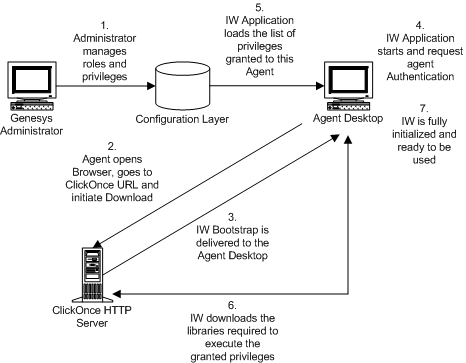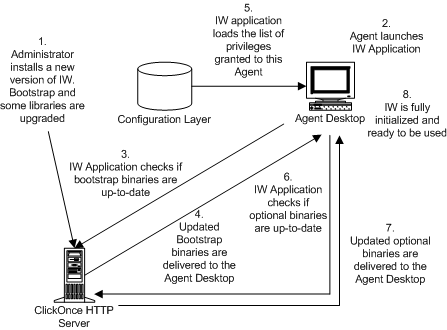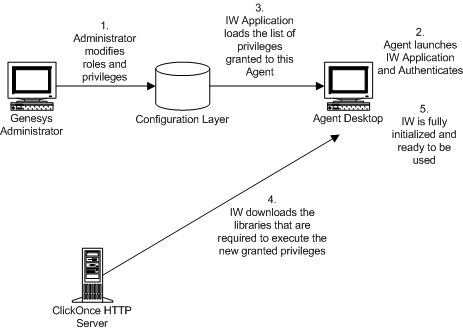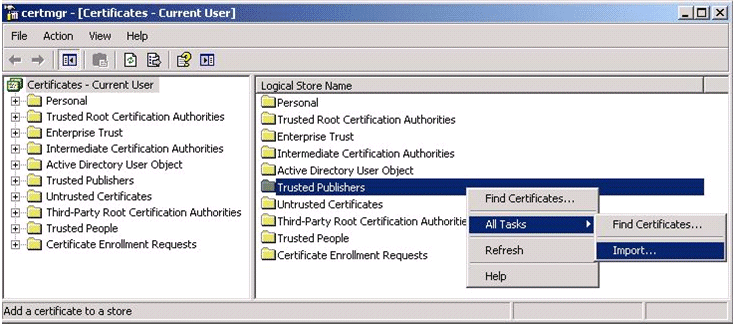Deployment Overview
Contents
Interaction Workspace can be deployed in one of three ways, depending on whether you want a ClickOnce or a non-ClickOnce deployment. Optionally, you can choose to install the developer package to customize and extend the capabilities of Interaction Workspace. Refer to Table - Interaction Workspace Install Mode Deployment Packages for the list and description of items that are installed by the Interaction Workspace Deployment Application.
|
Package name |
Purpose |
Folder contents |
|---|---|---|
| Prepare a ClickOnce package | Enables IT and administrators to install the Interaction Workspace ClickOnce package on a WebServer. | The Interaction Workspace folder contains the following folders or files:
|
| Install Interaction Workspace Developer Toolkit | Intended for developers, testers, or those who are demonstrating the application. It contains all the deliverables, including the API references, Interaction Workspace, Deployment Manager, and Samples. Note: In this prototype release, this mode is not yet available. If you choose this option, not everything that you require will be installed. | The destination folder contains the following folders or files:
|
| Install Interaction Workspace application | Intended for agents, testers, or those who are demonstrating the application. It contains only the agent application. | The destination folder contains the following folder:
|
ClickOnce Deployment
ClickOnce enables a safe and secure workflow that enables agents to be authenticated and then granted access only to specific privileges. Initially, agents are given a URL (through e-mail, a corporate portal, or a desktop shortcut) that links to the ClickOnce server. When they navigate to the server, the Interaction Workspace application is downloaded to their workstation. The application automatically starts, and agents are prompted to authenticate through the login window. When upgrades are made available, they are automatically delivered to agents upon login. The basic steps for a ClickOnce deployment are as follows:
- Perform Procedure: Installing Interaction Workspace Deployment Package on the Windows operating system, which guides you through the steps for installing Interaction Workspace on your Windows web server from the Interaction Workspace CD/DVD.
- Deploy the ClickOnce package on your web server by using the following Procedure: Deploying the Interaction Workspace downloadable package (ClickOnce) on your web server.
- Start the application bootstrap to install, upgrade, or start the application.
- Test the client application by using the following Procedure: Configuration verification: Testing the client.
Non-ClickOnce Deployment
You can install Interaction Workspace on a workstation without a ClickOnce deployment. This installation includes only the agent application. This installation option is used mainly to test Interaction Workspace on your system, not for enterprise-wide deployment. The basic steps for a Non-ClickOnce deployment are as follows:
- Modify the Configuration Server host, port, and application name parameters in the InteractionWorkspace.exe.config file to conform with your system. This file is in the Interaction Workspace directory on the Interaction Workspace CD/DVD.
- Perform Procedure: Installing the Interaction Workspace application on a client desktop, which guides you through the steps for installing Interaction Workspace on an end-user desktop from the Interaction Workspace CD/DVD.
- Start the application.
- Test the client application by using the following procedure: Procedure: Configuration verification: Testing the client.
Customization Package Deployment
You can install the Interaction Workspace application, API references, Deployment Manager, and Samples on a development workstation as follows: Perform Procedure: Installing Interaction Workspace Customization on the Windows operating system, which guides you through the steps for installing Interaction Workspace Customization on a development workstation from the Interaction Workspace CD/DVD.
ClickOnce Deployment Principles
ClickOnce provides a smooth experience for both the user and the network administrator. The user launches the application by using either a URL or a desktop icon. The URL can be provided to agents by e-mail, a corporate portal, a desktop shortcut, or other means. This simple method enables you to install the Interaction Workspace application on every workstation easily. When an agent accesses the URL the Interaction Workspace application is downloaded to the agent's workstation; it automatically starts and the login window is displayed. For subsequent application starts, the agent can reuse the initial URL or execute the application through a desktop icon or through the Start menu. If a hot fix or update is required or made available on the server, Interaction Workspace automatically upgrades the next time that the agent starts the application without you having to push-out a fix or update to every user.
ClickOnce enables you to deploy a security-enabled centralized WebService. Microsoft ClickOnce deployment technology that simplifies the privilege of publishing Windows-based applications to a web server or other network file share.
ClickOnce eliminates the need to reinstall the entire application whenever updates occur. Updates are provided automatically when an agent logs in. Only those portions of the application that have changed are downloaded to the client.
ClickOnce applications are entirely self-contained, they do not rely on shared resources. This means that you can update other resources without any impact on Interaction Workspace, or you can update Interaction Workspace without breaking other applications. Another advantage of ClickOnce is that administrative permissions are not required for the update to be installed. The update is installed automatically from the server when an authorized client logs in.
Scenarios: ClickOnce Principles
The following three scenarios demonstrate the utility of the ClickOnce approach to application and system security management:
- Initial installation
- Application patch
- Update of agent privilege permissions
The application patch and permission-update scenarios can occur simultaneously.
Initial Installation
For the initial installation onto the client workstation, the following prerequisites must be met:
- The Interaction Workspace application must be installed as a ClickOnce package on the HTTP Server that enables ClickOnce.
- Microsoft .NET Framework 3.5 SP 1 must be installed on the client workstation.
The Figure - Initial ClickOnce installation of the Interaction Workspace (IW) application shows the steps in a typical first installation of Interaction Workspace in a ClickOnce environment:
- The administrator manages the roles and privileges of the contact-center agent by using Genesys Administrator and stores the configurations in the Configuration Layer. Through e-mail, the corporate portal, or other notification, agents are provided with the application URL.
- Agents use the URL to go to the ClickOnce HTTP Server and initiate the download.
- The Interaction Workspace Application Bootstrap is delivered to the agent workstation; then the Interaction Workspace application launches and agents are prompted for authentication information. Note: Agents provide their credentials and are authenticated on the network.
- The Interaction Workspace application starts and requests agent authentication.
- The Interaction Workspace application loads the list of privileges that are granted to each agent, based on agent authentication.
- The Interaction Workspace application then downloads the libraries that are required to execute the granted privileges.
- Interaction Workspace is fully initialized and ready to be used.
Applying a Patch
To apply a patch to the installation on the client workstation, the following prerequisites must be met:
- The agent has run Interaction Workspace and has been successfully authenticated at least once on the current workstation.
- Privileges that are granted to the agent have not been changed since their previous authentication.
The Figure - Patching of the Interaction Workspace (IW) application through ClickOnce shows the steps in a typical patch installation of Interaction Workspace in a ClickOnce environment:
- The administrator installs a new version of the Interaction Workspace Bootstrap and upgrades one or more libraries.
- Agents launch the Interaction Workspace application on their desktop by using the URL or by double-clicking the desktop icon. The agent is authenticated.
- The Interaction Workspace application checks the ClickOnce HTTP Server to determine if the bootstrap binaries are up to date.
- The updated bootstrap libraries are delivered to the agent workstation.
- The Interaction Workspace application loads the list of privileges that are granted to each agent, based on agent authentication.
- The Interaction Workspace application checks the ClickOnce HTTP Server to determine if the optional binaries are up to date.
- Updated binaries, if any, are delivered to the agent workstation.
- The Interaction Workspace application is fully initialized and ready for agent use.
Limitation of Patching with ClickOnce
Because of the architecture of Interaction Workspace and the underlying Platform SDK and Enterprise SDK on which it is built, patches are applied to groups of assemblies, not just to a single assembly. Therefore if one assembly in a group is updated, the whole group must be patched.
Update Agent Privilege Permissions
To update the Interaction Workspace installation on the client workstation with updated privilege permissions, the following prerequisites must be met:
- The agent has run Interaction Workspace and has been successfully authenticated at least once on the current workstation.
- The Interaction Workspace application has not been upgraded on the ClickOnce server since the previous login.
Privilege Updates While the Agent is Not Logged In
The Figure - Update of the agent's role through ClickOnce shows the steps in a typical privilege-permission upgrade of Interaction Workspace in a ClickOnce environment if the agent is not already logged in:
- The administrator modifies the roles and privileges of the contact-center agent by using Genesys Administrator and stores the modified configurations in the Configuration Layer.
- Agents launch the Interaction Workspace application on their desktop by using the URL or by double-clicking the desktop icon. The agents are authenticated.
- The Interaction Workspace application loads the list of privileges that are granted to each agent, based on agent authentication.
- The Interaction Workspace application then downloads the missing libraries that are required to execute the new granted privileges.
- Interaction Workspace is fully initialized and ready for agent use.
Privilege Updates While the Agent Is Logged In
If new privileges are granted to the agent while the agent is logged in, the additional libraries will not be downloaded to the agent's workstation; however, if privileges are removed, this change is taken into account immediately to ensure security.
If multiple users share the same workstation, the download behavior depends on whether each agent has a unique account or whether all agents share the same account. If each agent has a unique account, then updates are downloaded by account. Therefore, each user will have to download updates. The advantage of this scenario is that multiple agents with different roles can share the same workstation without compromising security. If all users share a generic account, then only a single instance of the application is downloaded. This means that each user will have the same role as that assigned to the first user to download the application.
Security Constraints
To deploy Interaction Workspace, three deliverable subsets are installed on the agent workstation:
- Prerequisites: Microsoft .NET Framework 3.5 Service Pack 1.
- Mandatory executable: Interaction Workspace Application Bootstrap (.exe file and mandatory DLL assemblies).
- Optional assemblies: The list of optional assemblies depends on the privileges that are granted to the agent who logs in to the application.
The .NET Framework and service pack are not installed through the ClickOnce system; they are installed by the ClickOnce Bootstrap application (see the Figure - Initial ClickOnce installation of the Interaction Workspace (IW) application and Figure Patching of the Interaction Workspace (IW) application through ClickOnce). Therefore, more rights are required on the target computer to install the prerequisite than to install Interaction Workspace. The Interaction Workspace Application Bootstrap and the optional assemblies are pure ClickOnce deliverables; therefore, the full ClickOnce security model applies to these installables. However, the .NET Framework does not have the same security constraints. Therefore, Genesys recommends that you deploy the agent application in two phases:
- Installation of .NET Framework by the administrator by using the ClickOnce Bootstrapper, or by using the standard network distribution.
- Installation of Interaction Workspace by the agents at the initial login.
You can find more information about ClickOnce security at this URL: [http://msdn.microsoft.com/en-us/library/76e4d2xw(VS.80).aspx
Code Access Security
Code Access Security (CAS) is a mechanism that limits system access to the permissions that are granted to each code. CAS protects resources and operations and enables you to grant permissions to assemblies -- giving a high degree of control over what resources the assemblies can access. For example, restrictions can be applied to file-system locations, the registry, and specific name spaces.
Setting Code Access Security Permissions
You must set CAS permissions for both the Interaction Workspace ClickOnce application and the zone from which the application will be installed (for example, your local intranet, the Internet, and so on). Interaction Workspace must be defined as a Full Trust application. A Full Trust application is granted all access to any resource. Granting this level of permission is necessary because some of the embedded DLLs require Full Trust permissions. If Interaction Workspace is not defined as a Full Trust application, execution failures will occur when the application tries to access a restricted resource.
Machine Access Security
The Interaction Workspace application, which is deployed by ClickOnce, uses CAS permissions. This means that Interaction Workspace might require more permissions than are allowed by your security policy. In this case, ClickOnce will allow an automatic elevation of privileges. However, if the publisher is not trusted, a Machine Access security warning is prompted, but no security warning is prompted if the publisher of Interaction Workspace is trusted.
|
|
ClickOnce and Installation Security
The minimum class privilege for running a ClickOnce application is User. A Guest account cannot deploy a ClickOnce application through the network. If an agent is logged in with a User account, ClickOnce will automatically elevate the privileges for installing the application on the agent's workstation. If the publisher of ClickOnce deployment is Trusted, the installation will run without any prompting; however, if the publisher is not Trusted, the agent will be prompted to Trust the publisher of the deployment.
ClickOnce and Location Security
To deploy an application via ClickOnce, the ClickOnce HTTP server must be in a Trusted Zone, such as your local intranet, or be listed in Trusted Sites.
ClickOnce and Publisher Security
You must consider two publishers when you are deploying a ClickOnce application: the publisher of the application and the publisher of the deployment. The Interaction Workspace Deployment Wizard updates some application files; therefore, the application manifest must be signed after these updates. The Interaction Workspace Deployment Wizard must be enabled to sign both the application and deployment manifests. To sign the manifests, the Interaction Workspace Deployment Wizard requires a security certificate. The same security certificate can be used to sign both manifests.
Certificate Deployment Overview
You must provide a permanent certificate that is used to sign the Interaction Workspace installer manifest. This certificate is pointed to during installation. You can obtain your own certificate by one of the following methods:
- Generate a self-signed certificate by using the Makecert.exe file.
- Purchase a third-party verified certificate
- Generate a certificate by using Windows Certificate Server
Refer to the Genesys 8.0 Security Deployment Guide to review a detailed procedure about how to create a certificate.
Deploying Certificates on a Workstation
The Interaction Workspace Deployment Wizard requires you to do one of the following:
- Provide a security certificate.
- Generate a self-signed security certificate in the Interaction Workspace Deployment Wizard.
You must retain the Certificate file for all upcoming updates. If the updated version is signed by a different certificate, ClickOnce will consider it as a new installation, which means that you will have to uninstall the previous version by using Add/Remove Programs command on each client workstation.
Application and Deployment Signing Cases
The Table - Summary of the Cases for Signing the Application and the Deployment for the Integrator and the User provides a summary of the cases for signing the application and the deployment for the Integrator and the User, along with the impact for the user.
|
|
Integration |
User administration |
User impact |
|---|---|---|---|
| Application Verisign Certificate | Non-modifiable application | A prompt to trust the known publisher is displayed. | |
| Add the certificate in Trusted Publishers store (see Figure - Importing a Trusted Publisher). | No warning is displayed. | ||
| Application Self-Certification | Non-modifiable application | A prompt to trust the unknown publisher is displayed. | |
| Add the certificate in the Trusted Root Certification Authorities store (see Figure - Importing a Trusted Root Certification Authority) and in the Trusted Publishers store (see Figure - Importing a Trusted Publisher). | No warning is displayed. | ||
| Deployment Verisign Certificate | N/A | Sign the Deployment. | A prompt to trust the known publisher is displayed. |
| Sign the Deployment and Add the certificate in the Trusted Publishers store (see Figure - Importing a Trusted Publisher). | No warning is displayed. | ||
| Deployment Self-Certification | N/A | Sign the Deployment. | A prompt to trust the unknown publisher is displayed. |
| Sign the Deployment and Add certificate in the Trusted Root Certification Authorities store (see Figure 2) and in the Trusted Publishers store (see Figure 1). | No warning is displayed. |
Trusted Publishers
For a publishers to be consider a Trusted Publisher, the following criteria must be met:
- The publisher certificate must be installed in the Trusted Publishers certificate store on the user's computer.
- The issuing authority of the publisher certificate must have its own certificate installed in the Trusted Root Certification Authorities certificate store (This is already included in Verisign).
If the issuer of the certificate is not in the Trusted Root Certification Authorities certificate store, or if the publisher is not in the Trusted Publishers certificate store, the user will be prompted with a dialog box that asks for confirmation. For more information on Trusted Publisher certificates, refer to the following article: http://msdn.microsoft.com/en-us/library/ms996418.aspx
Deploying Certificates on the Network
There are two methods for deploying certificates over a network to a large number of client workstations:
- Active Directory domain
- certmgr.exe tool
Active Directory Domain
If you run in an Active Directory (AD) domain, use the AD Group Policy Objects (GPO) to distribute certificates centrally. For the root Certificate Authorities (CA) certificate, add a GPO to AD, and then link to the appropriate level (usually the domain level).
- Go to: Computer Settings>Windows Settings>Security>Public Key Policies.
- Add the root CA certificate under Trusted Root Certification Authorities.
Next you must distribute the trusted publisher. Add a GPO to AD and link at the appropriate level (usually for the organizational unit that should trust the application).
- Go to User Settings>Windows Settings>Internet Explorer Maintenance>Security>Authenticode Settings.
- Click Import.
- Click Modify.
- Enable the Lock down Trusted Publishers feature to prevent users from modifying their Trusted Publisher certificate store.
After the standard GPO-replication-to-clients occurs, every client trusts your CA and the Trusted Publisher certificate. Users will not receive Trust challenges for applications that are signed with corporate certificates. For more information on this topic, refer to the following technical article: http://msdn.microsoft.com/en-us/library/aa719097.aspx#clickonce_topic6
certmgr.exe Tool
You can use the certmgr.exe tool to install the certificate on each client workstation. See the following technical article for more information: http://msdn.microsoft.com/en-us/library/ms996418.aspx#clickoncetrustpub_topic5
Modifying Agent Workstations
Installation of Interaction Workspace results in the following modifications to your agent workstations:
- Interaction Workspace is added to the Start menu.
- Interaction Workspace is added to the Add/Remove Programs group in the Control Panel.
- The Interaction Workspace icon is added to the desktop.
- ClickOnce stores the application binaries and associated data files in directories that it creates and manages in the user-profile Local Settings folder or other location.
To determine the folder locations at which ClickOnce has stored the application binaries, launch Interaction Workspace, and open the About dialog box from the Help menu. Press Ctrl-Click on the Genesys icon to display hidden buttons that enable you to access the exe, data, log, and GC folders. Nothing is added to the Program Files folder or the registry. No administrative rights are required for the agent to install the application.





